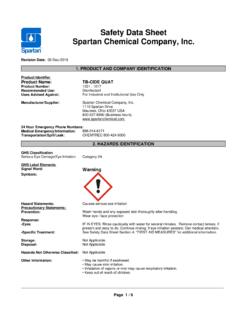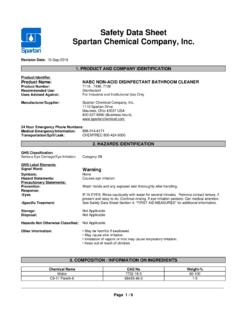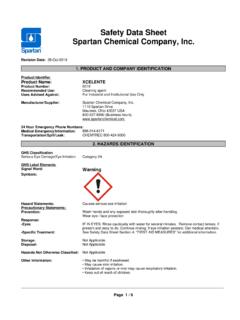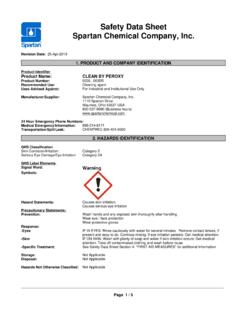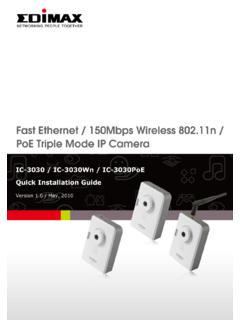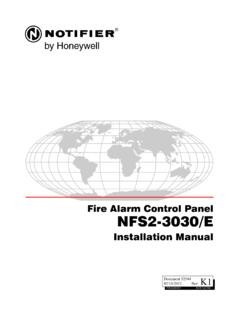Transcription of Safety Data Sheet Spartan Chemical Company, Inc.
1 Revision Date: 16-Dec-2020 1. PRODUCT AND company IDENTIFICATION Product Identifier Product Name: GLASS CLEANER (BULK) Product Number: 3030 , 3261 Recommended Use: Glass cleaner Uses Advised Against: For Industrial and Institutional Use Only Manufacturer/Supplier: Spartan Chemical company , Spartan DriveMaumee, Ohio 43537 USA 800-537-8990 (Business hours) 24 Hour Emergency Phone Numbers: Medical Emergency/Information: 888-314-6171 Transportation/Spill/Leak: CHEMTREC 800-424-9300 2. HAZARDS IDENTIFICATION GHS Classification GHS Label Elements Signal Word: Warning Hazard Statements: Combustible liquid Precautionary Statements: Prevention: Keep away from heat/sparks/open flames/hot surfaces. No smokingWear protective glovesWear eye / face protection Response: -Specific Treatment: See Safety data Sheet Section 4: "FIRST AID MEASURES" for additional information. Fire: Water spray, fog or alcohol-resistant foam, Carbon dioxide, for extinction Storage: Store in a well-ventilated place.
2 Keep cool Disposal: Dispose of contents and container in accordance with local, state and federal regulations. Hazards Not Otherwise Classified: Not Applicable Other Information: May be harmful if swallowed May cause skin irritation. May cause eye irritation Inhalation of vapors or mist may cause respiratory irritation. Keep out of reach of children 3. COMPOSITION / INFORMATION ON INGREDIENTS Safety data SheetSpartan Chemical company , Inc. Flammable Liquids Category 4 Symbols: None _____ Page 1 / 5 None _____ 3030 - GLASS CLEANER (BULK) Revision Date: 16-Dec-2020 Chemical Name CAS No Weight-% Water 7732-18-5 60-100 Isopropyl Alcohol 67-63-0 1-5 Sodium Sesquicarbonate 533-96-0 Caprylyl/Carpyl Glucoside 68515-73-1 < Lauryl Glucoside 110615-47-9 < Sodium Myristoyl Sarcosinate 30364-51-3 < Fragrance PROPRIETARY < Ammonium Hydroxide 1336-21-6 < CI 74180 1330-38-7 < Methylchloroisothiazolinone 26172-55-4 < Methylisothiazolinone 2682-20-4 < Specific Chemical identity and/or exact percentage of composition has been withheld as a trade secret.
3 4. FIRST AID MEASURES -Eye Contact: Rinse cautiously with water for at least 15 minutes. Remove contact lenses, if present and easy to do. Continue rinsing. If eye irritation persists: Get medical attention. -Skin Contact: Wash with soap and water. If skin irritation occurs: Get medical attention. -Inhalation: Remove victim to fresh air and keep at rest in a position comfortable for breathing. Call a poison control center or physician if you feel unwell. -Ingestion: Rinse mouth. Do NOT induce vomiting. Never give anything by mouth to an unconscious person. Get medical attention if you feel unwell. Note to Physicians: Treat symptomatically. 5. FIRE-FIGHTING MEASURES Suitable Extinguishing Media: Water spray (fog), Alcohol resistant foam, Carbon dioxide, Move containers from fire area if you can do it without risk Specific Hazards Arising from the Chemical : Vapors may travel to areas away from work site before igniting/flashing back to vapor source.
4 Hazardous Combustion Products: May include Carbon monoxide Carbon dioxide and other toxic gases or vapors. Protective Equipment and Precautions for Firefighters: Wear MSHA/NIOSH approved self-contained breathing apparatus (SCBA) and full protective gear. Cool fire-exposed containers with water spray. 6. ACCIDENTAL RELEASE MEASURES Personal Precautions: Remove all sources of ignition. Avoid contact with skin, eyes or clothing. Use personal protective equipment as required. Environmental Precautions: Do not rinse spill onto the ground, into storm sewers or bodies of water. Methods for Clean-Up: Prevent further leakage or spillage if safe to do so. Contain and collect spillage with non-combustible absorbent material, ( sand, earth, diatomaceous earth, vermiculite) and place in container for disposal according to local / national regulations (see Section 13). 7. HANDLING AND STORAGE Advice on Safe Handling: Handle in accordance with good industrial hygiene and Safety practice.
5 Wash thoroughly after handling. Storage Conditions: Keep away from heat, sparks, flame and other sources of ignition ( , pilot lights, electric motors and static electricity). Expiration Date: 2 years from date of manufacture. 8. EXPOSURE CONTROLS / PERSONAL PROTECTION _____ Page 2 / 5 None _____ 3030 - GLASS CLEANER (BULK) Revision Date: 16-Dec-2020 Occupational Exposure Limits: Chemical Name ACGIH TLV OSHA PEL NIOSH Isopropyl Alcohol 67-63-0 STEL: 400 ppm TWA: 200 ppm TWA: 400 ppm TWA: 980 mg/m3 (vacated) TWA: 400 ppm (vacated) TWA: 980 mg/m3 (vacated) STEL: 500 ppm (vacated) STEL: 1225 mg/m3 IDLH: 2000 ppm TWA: 400 ppm TWA: 980 mg/m3 STEL: 500 ppm STEL: 1225 mg/m3 CI 74180 1330-38-7 TWA: 1 mg/m3 Cu dust and mist - IDLH: 100 mg/m3 Cu dust and mist TWA: 1 mg/m3 Cu dust and mist Engineering Controls: Provide good general work practices generate dust, fumes, gas, vapors or mists which expose workers to chemicals above the occupational exposure limits, local exhaust ventilation or other engineering controls should be considered.
6 Personal Protective Equipment Eye/Face Protection: Wear splash goggles. Skin and Body Protection: Wear rubber or other Chemical -resistant gloves. Respiratory Protection: Not required with expected occupational exposure limits are exceeded or respiratory irritation occurs, use of a NIOSH/MSHA approved respirator suitable for the use-conditions and chemicals in Section 3 should be considered. General Hygiene Considerations: Wash hands and any exposed skin thoroughly after 29 CFR for further guidance. 10. STABILITY AND REACTIVITY Reactivity: This material is considered to be non-reactive under normal conditions of use. Chemical Stability: Stable under normal conditions. Possibility of Hazardous Reactions: Not expected to occur with normal handling and storage. Conditions to Avoid: Heat, flames and sparks. Incompatible Materials: Strong oxidizing agents. Strong acids. Hazardous Decomposition Products: May include carbon monoxide, carbon dioxide (CO2) and other toxic gases or vapors.
7 11. TOXICOLOGICAL INFORMATION 9. PHYSICAL AND Chemical PROPERTIES Appearance/Physical State: Liquid Color: Clear Blue Odor: Floral fragrance pH: Melting Point / Freezing Point: No information available Boiling Point / Boiling Range: > 66 C / 151 F Flash Point: 66 C / 151 F Pensky-Martens Closed Cup (PMCC) Evaporation Rate: < 1 (Butyl acetate = 1) Flammability (solid, gas) No information available Upper Flammability Limit: No information available Lower Flammability Limit: No information available Vapor Pressure: No information available Vapor Density: No information available Specific Gravity: Solubility(ies): Soluble in water Partition Coefficient: No information available Autoignition Temperature: No information available Decomposition Temperature: No information available Viscosity: _____ Page 3 / 5 None No information available _____ 3030 - GLASS CLEANER (BULK) Revision Date: 16-Dec-2020 Likely Routes of Exposure: Eyes, Skin, Ingestion, Inhalation.
8 Symptoms of Exposure: -Eye Contact: Pain and redness. -Skin Contact: Drying of the skin. -Inhalation: Nasal discomfort and coughing. -Ingestion: Pain, nausea, vomiting and diarrhea. Immediate, Delayed, Chronic Effects Product Information: data not available or insufficient for classification. Target Organ Effects: -Eyes. Respiratory System. -Skin. Numerical Measures of Toxicity The following acute toxicity estimates (ATE) are calculated based on the GHS document. ATEmix (oral): 93928 mg/kg ATEmix (inhalation-dust/mist): mg/l Component Acute Toxicity Information Chemical Name Oral LD50 Dermal LD50 Inhalation LC50 Water 7732-18-5 > 90 mL/kg ( Rat ) Not Available Not Available Isopropyl Alcohol 67-63-0 = 1870 mg/kg ( Rat ) = 4059 mg/kg ( Rabbit ) = 72600 mg/m3 ( Rat ) 4 h Ammonium Hydroxide 1336-21-6 = 350 mg/kg ( Rat ) Not Available Not Available CI 74180 1330-38-7 > 5 g/kg ( Rat ) Not Available Not Available Methylchloroisothiazolinone 26172-55-4 = 481 mg/kg ( Rat ) Not Available = mg/L ( Rat ) 4 h Carcinogenicity: No components present at or greater are listed as to being carcinogens by ACGIH, IARC, NTP or OSHA.
9 12. ECOLOGICAL INFORMATION Ecotoxicity Chemical Name Algae/Aquatic Plants Fish Toxicity to Microorganisms Crustacea Isopropyl Alcohol 67-63-0 1000: 96 h Desmodesmus subspicatus mg/L EC50 1000: 72 h Desmodesmus subspicatus mg/L EC50 9640: 96 h Pimephales promelas mg/L LC50 flow-through 11130: 96 h Pimephales promelas mg/L LC50 static 1400000: 96 h Lepomis macrochirus g/L LC50 Not Available 13299: 48 h Daphnia magna mg/L EC50 Ammonium Hydroxide 1336-21-6 Not Available : 96 h Pimephales promelas mg/L LC50 Not Available : 48 h water flea mg/L EC50 : 48 h Daphnia pulex mg/L EC50 Methylchloroisothiazolinone 26172-55-4 - : 72 h Pseudokirchneriella subcapitata mg/L EC50 static - : 96 h Pseudokirchneriella subcapitata mg/L EC50 static : 96 h Oncorhynchus mykiss mg/L LC50 semi-static Not Available : 48 h Daphnia magna mg/L EC50 - : 48 h Daphnia magna mg/L EC50 Flow through - : 48 h Daphnia magna mg/L EC50 Static Persistence and Degradability: No information available.
10 Bioaccumulation: No information available. Other Adverse Effects: No information available 13. DISPOSAL CONSIDERATIONS Disposal of Wastes: Dispose of in accordance with federal, state and local regulations. _____ Page 4 / 5 None _____ 3030 - GLASS CLEANER (BULK) Revision Date: 16-Dec-2020 Contaminated Packaging: Dispose of in accordance with federal, state and local regulations. 14. TRANSPORT INFORMATION DOT: Not Regulated Proper Shipping Name: Non-Hazardous Product Special Provisions: This product qualifies for exemptions outlined in 49 CFR (e)2. Aqueous solutions of alcohol containing 24% or less alcohol by volume and no other hazardous material is not subject to the requirements of the Class 3 Flammable Liquids subchapter if it contains no less than 50% descriptions may vary based on mode of transport, quantities, package size, and/or origin and destination. Check with a trained hazardous materials transportation expert for information specific to your situation.

